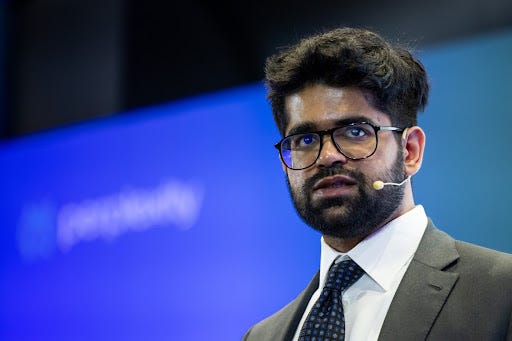Contents
Insights
No one cares when presidential advisers want bigger government
‘I tell startups to leave Europe,’ says Dutch CEO of tech unicorn Remote
AI
Perplexity wants to reinvent the web browser with AI—but there’s fierce competition
Tencent Unveils AI Model to Rival DeepSeek’s Rapid Response System
Anthropic’s new ‘hybrid reasoning’ AI model is its smartest yet
Claude 3.7 Sonnet debuts with “extended thinking” to tackle complex problems
Industry Analysis
Venture Capital
Stripe valuation surges to $91.5 billion, reflecting VC hopes and fears
VC Firm Slow Ventures Is Investing $60 Million in Content Creators. Here’s What It’s Looking For
Snowflake grows startup accelerator with $200M in new capital
Venus Williams backs French startup that rewards you for walking
Interview of the Week
Yoni Applebaum and Andrew Keen
Startup of the Week
Post of the Week
Stripe at $1.4 trillion
Editorial: Civilization: What is it Good For?
In an age where technological advancement is reshaping our world at unprecedented speed, we find ourselves asking fundamental questions about the purpose and value of civilization itself. This week’s curated articles offer a fascinating glimpse into the transformative power of human ingenuity, particularly in the realm of artificial intelligence, not to mention a thriving conversation.
The Promise of Human Achievement
David Brooks reminds us in his essay “We Can Achieve Great Things” that humanity has an extraordinary capacity for progress, despite the systems we sometimes build that hinder our own advancement. As he points out, there’s a paradox where “Progressives, who believe in using government to do good things, have built a system that renders government incompetent.” This tension between aspiration and implementation runs through many of our greatest civilizational challenges.
My View: Brooks identifies a critical contradiction, but I see government’s role as evolutionary rather than static. While I believe in progress as our fundamental trajectory, government should serve as humanity’s collective agent—a temporary scaffold supporting our climb toward abundance. The inefficiencies Brooks highlights aren’t inherent to governance but reflect our current developmental stage. As our technological capabilities expand and wealth creation accelerates, government’s role should naturally diminish, giving way to systems that maximize individual flourishing. Until then, we need governance that efficiently enables innovation rather than impedes it.
The AI Revolution Accelerates
The pace of AI development continues to accelerate, with major players introducing increasingly sophisticated models. Anthropic’s Claude 3.7 Sonnet represents a significant leap forward with its “hybrid reasoning” capabilities that allow it to “solve more complex problems and outperform previous models in areas like math and coding.” This evolution in AI reasoning reflects our civilization’s persistent drive to create tools that augment human intelligence.
Meanwhile, OpenAI has unveiled GPT-4.5 ‘Orion,’ described as “its largest AI model yet,” while Tencent has introduced Hunyuan Turbo S, which “can answer queries in under a second, significantly outpacing existing models.” The competitive landscape is driving rapid innovation, particularly as Chinese companies like DeepSeek continue to disrupt both domestic and international markets.
My View: The accelerating AI revolution represents our most promising path toward post-scarcity abundance. Each new model—Claude 3.7’s hybrid reasoning, GPT-4.5’s expanded capabilities, Hunyuan’s speed—represents another step toward systems that can solve humanity’s most intractable problems. This competitive innovation landscape is precisely what we need, as it drives exponential improvement across multiple fronts simultaneously. I see these developments not merely as technological curiosities but as the building blocks of a future where AI-driven abundance could ultimately render traditional governance structures obsolete, allowing for unprecedented individual autonomy and flourishing.
The Browser Wars Reimagined
Perhaps most intriguing is how AI is transforming our fundamental interfaces with information. As Michael Parekh notes, “a lot of people are working on the big idea of reinventing web browsers on desktops and mobile with AI.” Perplexity’s announcement of “Comet,” an AI-powered browser, signals a new front in the tech wars, with the company’s CEO Aravind Srinivas declaring: “Perplexity will be launching a new agentic browser: Comet very soon!”
My View: The reimagining of browsers represents a profound shift in how we access and process information—a critical component for progress. AI-powered browsers like Perplexity’s Comet will democratize knowledge, reducing information asymmetries that have historically concentrated power in the hands of governments and institutions. These tools will enable individuals to navigate complexity with greater autonomy, making informed decisions without institutional mediation. This transformation of our information interfaces is a crucial step toward the abundance-based society I envision, where individuals can flourish without the need for paternalistic oversight.
Reflection on Progress
Benedict Evans, in conversation with Ben Thompson, offers a nuanced perspective on AI’s current limitations, explaining that “while AI systems excel at answering open-ended questions and generating qualitative insights, they still struggle with precise, deterministic tasks.” This creates an interesting tension between the impressive capabilities of today’s language models and their inconsistent factual accuracy.
My View: Evans’ observation about AI’s current limitations highlights the evolutionary nature of technological progress. These limitations aren’t roadblocks but waypoints on our journey toward systems that combine creative insight with factual precision. I see this tension as productive—driving innovation while reminding us that progress isn’t linear. Government’s role during this transition should be to enable experimentation while establishing sensible guardrails, not to control or restrict development. As AI systems mature and overcome these limitations, they’ll increasingly enable the abundance that makes traditional governance structures less necessary. The path forward isn’t about choosing between technological optimism and pragmatic caution, but embracing both as we navigate toward a future where individual flourishing is maximized through technological abundance.
As we contemplate what civilization is good for, the answer lies in this persistent human drive to create tools that extend our capabilities, even as we grapple with their limitations. The true measure of our civilization may ultimately be how we harness these powerful technologies to address our greatest challenges while preserving our essential humanity.
In the words of tech analyst Benedict Evans, we find ourselves in a paradox of technological advancement: “on one hand, AI is progressing rapidly, while on the other, its true potential and the optimal ways to harness it remain shrouded in uncertainty.” This uncertainty itself may be civilization’s greatest strength—the space where human creativity, wisdom, and values can guide our technological future toward a world of abundance where individual freedom can truly flourish.
Essays of the Week
We Can Achieve Great Things
Author: David Brooks Source: NYT > Opinion Published: February 27, 2025 Classification: Essays Subcategory: Opinion
American political culture goes through phases. Between 1933 and 1963 that culture went through a Hamiltonian phase. Leaders believed in centralizing power to build big things. Franklin Roosevelt created the Tennessee Valley Authority and the rest of the New Deal. Dwight Eisenhower built the national highways system and founded NASA.
A lot of the stuff the centralizers did was great, like the New York infrastructure czar Robert Moses’ building Lincoln Center. Some of the stuff they did was horrific, like Robert Moses’ destroying Bronx neighborhoods to put in a highway.
Somewhere around the late ’60s the culture shifted in a decentralizing, Jeffersonian direction. A new generation of conservatives and progressives emerged who were suspicious of centralized authority and instinctively against the establishment, and who railed against “the system.” People with less power were automatically the good guys, and people with more power were automatically the bad guys.
On the right, Republicans from Ronald Reagan to the Tea Party crusaded against elites and the swamp in Washington. On the left, progressive activists like Ralph Nader and the environmentalists sued the government to halt development projects. Progressive community activists empowered neighborhoods to take on and stymie City Hall. Federal workers passed masses of regulations to micromanage everyday life on a work site. Republicans and Democrats joined forces to pass the National Environmental Policy Act, the California Environmental Quality Act and the Endangered Species Act, all of which could be used by activists to slow down and halt housing and transportation projects.
The decentralizing Jeffersonians overshot the mark. A group of activists who came of age during the New Deal era concentrated power to get things done. Then, a new generation of activists who came of age during the 1960s rebelled against concentrated power and made it nearly impossible to get anything done. This became the pattern.
In 2008 California set out to build high-speed rail between Los Angeles and San Francisco, promising that it would be finished in 2020. The project was blocked by a thousand little barriers, and now a scaled-down line between Merced and Bakersfield may open in 2033 at a cost, so far, of $35 billion.
In the United States it costs roughly $609 million to build a kilometer of rail. In Canada it costs only $295 million and in Portugal, $96 million. Because of regulations and the lack of cost-effective production, a basic elevator in New York City costs about four times as much as that same elevator in Switzerland.
A Theory of Media That Explains 15 Years of Politics
Author: Ezra Klein Source: NYT > Opinion Published: February 25, 2025 Classification: Essays Subcategory: Media and Politics Analysis
In this extensive conversation, Ezra Klein and media analyst Martin Gurri delve into the evolution of media and its impact on modern politics—a subject sparked by Gurri’s influential book, The Revolt of the Public. Originally self-published in the aftermath of the 2016 election, the book argued that the rise of digital media has decentralized the once-authoritative narrative of traditional institutions, leading to a turbulent, information-saturated political landscape.
The discussion begins by contrasting the hierarchical, top‐down media environment of the 20th century with today’s dynamic, digital era. Gurri explains that the digital revolution allowed for a multiplicity of voices, undermining the ability of institutions—whether government, media, or business—to fully control information. This shift, he argues, has fostered a continuous cycle of distrust and backlash where populist movements rise in opposition to established elites.
Klein highlights that modern politics is not driven solely by rational responses to material conditions, but also by the powerful momentum of media attention. From the emergence of cancel culture and fake news to dramatic political reversals, the transformation of information flow has redefined the dynamics of power and public sentiment. Gurri notes that while past leaders mastered the art of mediated communication (think Walter Cronkite or Reagan), today’s political figures—exemplified by Donald Trump and further amplified by social media—tap into the digital zeitgeist with a raw, unfiltered energy.
A key theme is the tension between free speech and control. The interview probes how both sides of the political spectrum struggle with regulating information. Conteporary debates over censorship, transparency, and executive power reflect broader cultural shifts. For instance, while Trump is portrayed as an icon of free speech—resonating with voters who crave a break from bureaucratic restraint—the conversation also explores how aggressive measures, such as executive actions against agencies like USAID, represent attempts to reshape governmental institutions using new digital and AI-driven approaches.
Toward the end, Klein and Gurri muse on the future of governance in an era defined by digital transformation. They envision a government that is leaner, more responsive, and heavily informed by AI and technology, yet caution that such a shift brings its own set of challenges. These include reconciling the demand for transparency with the need for discreet, effective administration, and ensuring that a political system responsive to public outcry does not descend into chaotic grandstanding.
Ultimately, the conversation reflects a broader debate about the legitimacy and future of modern political institutions as they adapt to the rapid changes in how information is produced, shared, and consumed.
Bezos Takes Control at the Washington Post
Author: Jeff Bezos Source: X Published: February 26, 2025 Classification: Media Subcategory: Transformation
The ChatGPT Prompts That Can Be $1B+ Companies
Author: Rex Woodbury Source: Digital Native Published: February 26, 2025 Classification: Startups Subcategory: AI Applications
In this article, Rex Woodbury explores how carefully crafted ChatGPT prompts could evolve into standalone apps with the potential to become billion-dollar companies. Inspired by Chris Paik’s theory—that any subreddit with over 1 million subscribers could support a venture-scale business—Woodbury draws parallels with the unbundling of established platforms like eBay and Craigslist. He suggests that as technology advances, vertical, niche applications built around specific prompts might outperform their horizontal counterparts.
Woodbury explains that what once required significant development time can now be rapidly prototyped using modern tools like Cursor. This lowering of barriers means that almost any useful, well-crafted prompt can be transformed into a dedicated app with a superior user experience. For example, he details a TikTok trend where creators share prompts that help users design a comprehensive life plan. One such prompt guides the user through setting goals, crafting a dream life story, and then generating a daily schedule complete with reminders and a goal tracker.
The Productization of Prompts
Imagine an app named Dream Life: upon downloading, the user is walked through a series of ten beautifully designed screens that ask targeted questions. Once completed, the app leverages the prompt to generate a personalized daily schedule and goal tracker. This kind of verticalization—offering a better, more focused product—illustrates the potential to extract significant value from what was once a simple ChatGPT query.
Woodbury also provides examples of prompts he has used himself. These include designing a workout regimen, summarizing essential books from the American literary canon, and even planning creative dinner parties. Each of these prompts is not only useful on its own but also ripe for productization into specialized apps that could serve niche markets with minimal investment.
The App-ocalypse 2.0
Reflecting on the evolution of app ecosystems since the early days of the App Store, Woodbury notes that while many early apps barely gained traction, those that managed to find their niche grew substantially. He foresees a similar trend in AI: even if many of the upcoming ChatGPT-powered apps may only capture a small segment of the market, a few will undoubtedly become highly profitable. Already, companies such as Function Health and Superpower are examples of startups turning advanced prompts into robust products.
In conclusion, the article posits that the rapid drop in software creation costs will soon lead to a proliferation of AI-generated apps. The brilliant ChatGPT prompt of today could pave the way for the next wave of blockbuster tech startups, fundamentally reshaping how software is built and consumed.
Not a Coder? With A.I., Just Having an Idea Can Be Enough.
Author: Kevin Roose Source: NYT Published: February 27, 2025 Classification: AI Subcategory: Productivity and Skills
I am not a coder. I can’t write a single line of Python, JavaScript or C++. Except for a brief period in my teenage years when I built websites and tinkered with Flash animations, I’ve never been a software engineer, nor do I harbor ambitions of giving up journalism for a career in the tech industry.
And yet, for the past several months, I’ve been coding up a storm.
Among my creations: a tool that transcribes and summarizes long podcasts, a tool to organize my social media bookmarks into a searchable database, a website that tells me whether a piece of furniture will fit in my car’s trunk and an app called LunchBox Buddy, which analyzes the contents of my fridge and helps me decide what to pack for my son’s school lunch.
These creations are all possible thanks to artificial intelligence, and a new A.I. trend known as “vibecoding.”
Vibecoding, a term that was popularized by the A.I. researcher Andrej Karpathy, is useful shorthand for the way that today’s A.I. tools allow even nontechnical hobbyists to build fully functioning apps and websites, just by typing prompts into a text box. You don’t have to know how to code to vibecode — just having an idea, and a little patience, is usually enough.
“It’s not really coding,” Mr. Karpathy wrote this month. “I just see stuff, say stuff, run stuff, and copy paste stuff, and it mostly works.”
My own vibecoding experiments have been aimed at making what I call “software for one” — small, bespoke apps that solve specific problems in my life. These aren’t the kinds of tools a big tech company would build. There’s no real market for them, their features are limited and some of them only sort of work.
But building software this way — describing a problem in a sentence or two, then watching a powerful A.I. model go to work building a custom tool to solve it — is a mind-blowing experience. It produces a feeling of A.I. vertigo, similar to what I felt after using ChatGPT for the first time. And it’s the best way I’ve found to demonstrate to skeptics the abilities of today’s A.I. models, which can now automate big chunks of basic computer programming, and may soon be capable of similar feats in other fields.
A.I. coding tools have existed for years. Earlier ones, like GitHub Copilot, were designed to help professional coders work faster, in part by finishing their lines of code the same way that ChatGPT completes a sentence. You still needed to know how to code to get the most out of them, and step in when the A.I. got stuck.
But over the past year or two, new tools have been built to take advantage of more powerful A.I. models that enable even neophytes to program like pros.
Data-driven VC is over
Author: Lawrence Lundy-Bryan Source: stateofthefuture.substack.com Published: February 27, 2025 Classification:Venture Capital Subcategory: VC Strategy and Research
Lawrence introduces himself as a research-led investor who now focuses on computing hardware and breakthrough architectures designed to meet the challenges of AI workloads. He reflects on his personal journey and shifts in his role—from being a dedicated researcher spending long hours in libraries to embracing rapid, digital research methods in the modern era.
Drawing a parallel with history, Lawrence tells the story of Jean-Baptiste, a master weaver whose craft was revolutionized by the introduction of automated systems. As Jacquard’s machine displaced traditional hand-weaving techniques, so too is deep research technology now poised to upend conventional venture capital (VC) methods. The message is clear: the age of differentiated, manual analysis may be ending.
Lawrence lays out his central argument. He posits that data-driven research (DR) has commoditized the twin pillars of VC—thesis development and market research. Where once large funds with abundant resources enjoyed exclusive information advantages, today any investor with access to sophisticated research tools can produce comprehensive market maps in just hours. This democratization dissolves traditional barriers and leads to a convergence in analysis across firms.
In this environment, almost every investor relies on the same data and insights, leading to homogeneous conclusions regarding emerging opportunities. When innovative sectors—like crypto, photonic memory, or even agent-native applications—begin to attract attention, the rapid, almost simultaneous recognition across the industry means that the competitive edge once provided by deep, proprietary research has evaporated.
However, there is a silver lining. Lawrence argues that in an era dominated by automated research, the ability to make what may seem like "irrational" decisions based on gut feel and emotional intelligence becomes a priceless asset. Historical examples, such as contrarian bets that defied conventional data yet yielded exceptional returns, underscore the enduring value of human wisdom. This wisdom, characterized by pattern recognition, contextual intelligence, and emotional integration, remains difficult to replicate by AI—even as research processes become increasingly standardized.
The article further observes that while major VC firms may struggle with the new paradigm, solo general partners and emerging managers are well positioned to thrive. Their nimble decision-making, accompanied by deep industry relationships and an intuitive grasp of what truly matters, offers a decisive competitive advantage in a market where data is universal but wisdom is scarce.
Ultimately, Lawrence concludes that as automated, deep research tools continue to influence the landscape, the art of venture capital will depend more on human judgment. It is this blend of intuition and experience that will differentiate successful investments in an era where pure data is no longer enough.
The ‘Spy Sheikh’ Taking the AI World by Storm
Author: Eliot Brown and Berber Jin Source: Wall Street Journal Published: February 27, 2025 Classification: Tech NewsSubcategory: Artificial Intelligence
Sheikh Tahnoon bin Zayed Al Nahyan, often dubbed the “spy sheikh,” is wielding his vast wealth to propel the United Arab Emirates to the forefront of the global artificial intelligence (AI) race. Best known as the national security adviser of Abu Dhabi and the brother of the nation’s president, Tahnoon is not only famous for his flamboyant lifestyle but also for his strategic investments in the burgeoning AI sector.
Tahnoon’s recent initiatives include channeling over $50 billion into MGX—an AI fund he leads—complemented by billions more earmarked for his company, Group 42. With control of Abu Dhabi’s two massive wealth funds, valued at an estimated $1.4 trillion in assets, he is uniquely positioned to influence how the global economy transforms through AI. His expansive strategy is highlighted by high-profile meetings with tech titans such as Apple, Microsoft, and BlackRock, alongside personal interactions with leaders like Mark Zuckerberg, Elon Musk, and Satya Nadella.
Unlike other investors who opt to concentrate funds in a few niches, Tahnoon is adopting a broad investment approach. He envisions not only significant deployments in chip plants and data centers but also the nurturing of local AI startups. His aim is to help construct a post-oil economic future for the region, turning Abu Dhabi into a global hub for AI innovation.
The story of Tahnoon is as multifaceted as his interests. From pioneering computer chess programs in his youth to now tracking global large language model developments on a custom-built dashboard, his passion for technology is evident. His earlier ventures into AI gained a new impetus after witnessing Google’s AlphaZero, which reshaped his understanding of the potential held by artificial intelligence.
However, Tahnoon’s journey is not without its geopolitical challenges. As the UAE balances its long-standing ties with China against its growing alignment with U.S. technologies, it faces a delicate diplomatic dance. U.S. officials have cautioned him about straddling the East-West divide, prompting a pivot towards American tech partnerships—evidenced by the injection of $1.5 billion from Microsoft into his company and the replacement of Chinese equipment with Western alternatives.
Amidst these high-stakes ventures, Tahnoon continues to cultivate his personal passions, from funding cycling teams to promoting Brazilian jiu jitsu. His integration of business, technology, and a flair for the dramatic makes him a distinctive figure in an era where massive investments in AI are reshaping the global tech landscape.
No one cares when presidential advisers want bigger government
Author: Christian Britschgi Source: Reason.com Published: February 27, 2025 Classification: Other Subcategory:Political Commentary
Elon Musk's unclear position on the federal government's organization chart continues to generate controversy and legal problems for the Trump administration.
Despite being the seemingly powerful, very public face of the Department of Government Efficiency (DOGE), with the full backing of President Donald Trump, the administration's lawyers claim in various court filings that Musk has no official role in either of the White House units bearing the DOGE label. Instead, as Reason's Jacob Sullum explained yesterday, they say that Musk is officially just a senior adviser to Trump within the White House office.
Opponents of DOGE have seized on Musk's unclear White House role to file lawsuits challenging DOGE's authority to access government data, shrink federal staff, and reorganize federal departments. A collection of Democratic attorney generals even filed a lawsuit claiming that Musk's role within the federal government is unconstitutional, contending that his vast apparent powers make him not merely an adviser but a principal officer who needs Senate confirmation.
Critics in the media have claimed that Musk has appointed himself as a "dictator" and that he's currently staging a coup within the federal government. Yet, Musk is hardly the first White House adviser to have great influence over government policy. His advisory role is only causing problems because DOGE's mission involves telling government workers what to do instead of bossing around private citizens and companies.
Contrast the uproar about Musk's position with the appointment of Andy Slavitt as a senior White House adviser on President Joe Biden's COVID-19 response task force. Slavitt, who initially entered government as part of the Obama administration team fixing the rollout of Healthcare.gov, later helped spawn the U.S. Digital Service – which has since been converted into the U.S. DOGE Service under Trump.
Slavitt's return to government as a non-Senate confirmed adviser proved totally uncontroversial throughout his six-month tenure. He frequently led press conferences announcing policy initiatives such as invoking the Defense Production Act to increase vaccine and test production, or adjusting Medicare and Medicaid payments for vaccine doses. His leading role on the vaccine drive was accepted without significant dispute, even as the effort involved extensive public and private sector coordination.
In contrast, despite the unclear boundaries of his authority, Musk’s advisory position has sparked legal challenges and heated debates over executive power. The Trump administration’s vague delineation of DOGE's powers has created confusion – sometimes stalling internal initiatives and inviting lawsuits over attempts to cut federal spending and reorganize personnel.
‘I tell startups to leave Europe,’ says Dutch CEO of tech unicorn Remote
Author: Siôn Geschwindt Source: The Next Web Published: February 26, 2025 Classification: Startups Subcategory:EU Tech Regulation
As the US and China pursue dominance in the global technology race, concerns are mounting among European founders that the region’s entrenched bureaucracy is impeding its capacity for innovation and growth.
The EU is going “overboard on tech regulation,” said Job van der Voort, CEO and founder of Remote, an HR tech company valued at over $3bn. “It’s stifling innovation and it’s a massive risk for Europe.”
Van der Voort told TNW that many business leaders share his view. “Most entrepreneurs agree this is a huge problem,” he said. Indeed, such concerns are being raised with growing frequency.
At a conference in Paris earlier this month, influential figures like Mistral CEO Arthur Mensch and DeepMind founder Demis Hassabis called for regulation in Europe that is “flexible enough” to support innovation and competitiveness. Not long after, Dutch software unicorn Bird announced plans to move most of its operations out of Europe to escape what it described as overregulation.
“I think more companies will be forced to do the same,” said van der Voort. “But the biggest impact will be at the early stage.”
He highlighted the ongoing trend of European startups crossing the Atlantic to scale. Research by London-based VC Hoxton Ventures revealed that nearly all European startups with over $500mn in revenue—including Spotify, Wise, and Adyen—found success by winning the US market.
Van der Voort believes burdensome tech regulation is pushing companies to look beyond Europe. “It’s becoming unattractive to start and maintain a business here,” he said. “That’s why I tell startups to leave Europe if they want to succeed.”
Van der Voort has practiced what he preaches. After founding Remote with Marcelo Lebre in 2019, they based the company in San Francisco, noting that it was simply easier to start their business there. Remote, which helps businesses hire and manage remote teams, raised $300mn in a Series C round in 2022, propelling its valuation above $3bn.
“The EU needs to consider its own fate over the next decades,” he warned. “Regulation standing in the way of innovation — that makes it harder for startups and is incredibly hurtful for the economy.”
Perplexity wants to reinvent the web browser with AI—but there’s fierce competition
Author: Samuel Axon Source: Ars Technica - All content Published: February 24, 2025 Classification: Tech NewsSubcategory: AI in Browser Technology
Natural-language search engine Perplexity is set to launch its new web browser, named Comet, marking its bold entry into a space long dominated by established names like Google. In a competitive and crowded market, Perplexity is positioning Comet as a potential game-changer, though at this early stage, details about its features or market positioning remain scarce.
The announcement came via a concise X post that featured a flashy animation, but offered little in the way of concrete information. Shortly after the initial reveal, Perplexity provided a link inviting users to sign up for beta access. This link directed interested parties to a minimalistic website, where a simple email form awaited—again, without additional details on what to expect from Comet.
Upon signing up, users received an email informing them that new users would be added to the beta on a weekly basis. The email also mentioned that the sign-up process could be expedited by sharing Comet on social media and tagging Perplexity's account.
Founded in 2022 by engineers with strong machine learning backgrounds, Perplexity has primarily built its reputation on its large language model-powered search engine. The platform distinguishes itself by not only gathering information from a wide range of sources but also by summarizing the content and presenting it in a user-friendly manner. The search engine further enhances user engagement through its ability to handle follow-up questions, allowing for deeper exploration of topics.
An Interview with Benedict Evans About AI Unknowns
Author: Ben Thompson Source: Stratechery Published: February 27, 2025 Classification: AI Subcategory: Interview
An Interview with Benedict Evans About AI Unknowns
Topics:
Deep Research | LLM Paradigms | AI UI | Commoditization and Differentiation | China AI | Regulation Revisited
Deep Research
Benedict Evans, welcome back to Stratechery.
BE: Thanks for having me.
I had to put on the emergency brake and immediately start recording because I had to save this for the pod. I was just telling you I was going back through the last six months of your newsletters, compiling interesting points, things for us to talk about. You observed, “Shouldn’t I have been using AI for this?”, a real fail on my part.
BE: Yeah, I mean, the second part of my comment was, I think Woody Allen had a joke about doing a speed reading course and reading War and Peace: apparently, it involves Russia.
How much can you compress? But that does actually seem like something that might actually be a good ChatGPT use case, which I’ve mentioned from time to time is something I sometimes struggle with.
Well, you wrote about Deep Research a couple of weeks ago and you were pretty disappointed in the output. They used a smartphone report as the demo and it’s interesting, because the Deep Research case that convinced me was actually interview prep, and the key thing about it was, it was a lot of qualitative information that was helpful, and I wasn’t looking for quantitative information. Does that ring true of your experience?
BE: It does, yes. There’s a lot of different things one can say about this, and most of what I said was, it’s kind of interesting and puzzling rather than just, “It’s crap”. It’s very easy to say, “This is amazing and it changes the world, and it’s the fifth industrial revolution”, and it’s very easy to say, “This is all a bunch of crap and it’s the biggest waste of time and money since NFTs, please subscribe to my Substack”, and leave it at that. But what I struggle with is, it’s actually much more interesting and more complicated.
Tencent Unveils AI Model to Rival DeepSeek’s Rapid Response System
Author: ODSC - Open Data Science Source: Stories by ODSC - Open Data Science on Medium Published: February 27, 2025 Classification: AI Subcategory: AI Model Releases
Chinese tech giant Tencent has introduced its latest AI model, Hunyuan Turbo S, boasting response speeds faster than DeepSeek’s widely praised R1. The release underscores growing competition among China’s top AI developers, as DeepSeek’s success continues to disrupt both domestic and international markets.
According to Tencent, Hunyuan Turbo S can answer queries in under a second, significantly outpacing existing models like DeepSeek R1 and its own Hunyuan T1. Unlike slower models that require extended processing time before generating responses, Turbo S delivers near-instant results.
Challenging DeepSeek’s AI Leadership
Tencent stated that Turbo S performs on par with DeepSeek-V3, particularly in areas such as knowledge-based reasoning, mathematical problem-solving, and logical inference. DeepSeek-V3 powers an AI chatbot that has even surpassed OpenAI’s ChatGPT in global app store downloads, marking a historic milestone for a Chinese AI firm. DeepSeek has yet to issue a response to these claims.
Since its launch, DeepSeek’s AI models have gained traction in Silicon Valley—a first for a Chinese firm—prompting major competitors like Tencent and Alibaba to accelerate their AI development. Last month, Alibaba introduced Qwen 2.5-Max, positioning it as a direct competitor to DeepSeek-V3.
Lowering AI Costs Amid Price Wars
Tencent also highlighted that Hunyuan Turbo S is significantly more cost-effective than its predecessors. DeepSeek’s strategy of open-sourcing its models and implementing low pricing has pressured rival firms to reduce costs and offer more competitive pricing structures.
With AI capabilities advancing rapidly, China’s major tech players are racing to refine their models and secure dominance in both domestic and global AI markets. The emergence of DeepSeek as a key competitor has reshaped the landscape, forcing legacy tech firms to adapt swiftly.
As AI innovation continues to evolve, the competition between DeepSeek, Tencent, and Alibaba signals a new era of accelerated advancements in China’s AI sector.
OpenAI unveils GPT-4.5 ‘Orion,’ its largest AI model yet
Author: Maxwell Zeff Source: TechCrunch Published: February 27, 2025 Classification: AI Subcategory: Large Language Models
OpenAI announced on Thursday it is launching GPT-4.5, the much-anticipated AI model code-named Orion. GPT-4.5 is OpenAI’s largest model to date, trained using more computing power and data than any of the company’s previous releases.
Despite its size, OpenAI notes in a white paper that it does not consider GPT-4.5 to be a frontier model.
Subscribers to ChatGPT Pro, OpenAI’s $200-a-month plan, will gain access to GPT-4.5 in ChatGPT starting Thursday as part of a research preview. Developers on paid tiers of OpenAI’s API will also be able to use GPT-4.5 starting today. As for other ChatGPT users, customers signed up for ChatGPT Plus and ChatGPT Team should get the model sometime next week, an OpenAI spokesperson told TechCrunch.
The industry has held its collective breath for Orion, which some consider to be a bellwether for the viability of traditional AI training approaches. GPT-4.5 was developed using the same key technique — dramatically increasing the amount of computing power and data during a “pre-training” phase called unsupervised learning — that OpenAI used to develop GPT-4, GPT-3, GPT-2, and GPT-1.
In every GPT generation before GPT-4.5, scaling up led to massive jumps in performance across domains, including mathematics, writing, and coding. Indeed, OpenAI says that GPT-4.5’s increased size has given it “a deeper world knowledge” and “higher emotional intelligence.” However, there are signs that the gains from scaling up data and computing are beginning to level off. On several AI benchmarks, GPT-4.5 falls short of newer AI “reasoning” models from Chinese AI company DeepSeek, Anthropic, and OpenAI itself.
Anthropic’s new ‘hybrid reasoning’ AI model is its smartest yet
Author: Alex Heath
Source: The Verge
Published: February 24, 2025
Classification: AI
Subcategory: Hybrid Reasoning Model
Anthropic is releasing Claude 3.7 Sonnet, its first “hybrid reasoning model” that can solve more complex problems and outperforms previous models in areas like math and coding.
In addition to the new model, Anthropic is also launching a “limited research preview” of its agentic coding tool, Claude Code. While Anthropic already powers AI coding utilities such as Cursor, the company is positioning Claude Code as an active collaborator that can search and read code, edit files, write and run tests, commit and push code to GitHub, and even operate command line tools.
Claude 3.7 Sonnet is available starting Monday through the Claude app and for developers via Anthropic’s API, Amazon Bedrock, and Google Cloud’s Vertix AI. Pricing remains consistent with its predecessor, Claude 3.5 Sonnet, at $3 per million input tokens and $15 per million output tokens.
Anthropic’s product research lead, Dianne Penn, explained to The Verge that the approach behind the update simplifies the experience. She noted: "We fundamentally believe that reasoning is a feature of the AI rather than a completely separate thing." Penn emphasized that while simple queries like “What time is it?” are answered rapidly, more complex prompts such as planning an entire trip incorporate additional processing.
The update has shown notable improvements in agentic coding, finance, and legal tasks. Although the model lacks real-time web search functionality, its knowledge cut-off—set in October 2024—ensures more current information. Additionally, Anthropic offers developers the ability to influence the model’s internal thought process through its scratchpad, and they may even set response time limits. Anthropic’s VP of product, Michael Gerstenhaber, mentioned that developers sometimes require responses in under 200 milliseconds—a choice that the company sees as a product decision.
Internally, Anthropic employees have experimented with Claude 3.7 Sonnet in a variety of creative projects ranging from front-end website design and interactive games to extended coding sessions that involve iterative test buildouts. In one striking example, the model was tested by mapping its API to a controller scheme to play an old-school Pokémon video game, with the updated version successfully defeating multiple gym leaders—unlike the earlier version that struggled to progress past Pallet Town.
With competitors like OpenAI advancing separate reasoning models, Anthropic’s development of a unified model capable of handling diverse tasks suggests a future where a single solution may suffice for all challenges.
Claude 3.7 Sonnet debuts with “extended thinking” to tackle complex problems
Author: Source: Published: February 25, 2025 Classification: AI Subcategory: Language Models
On Monday, Anthropic announced Claude 3.7 Sonnet—a new AI language model featuring a simulated reasoning capability known as "extended thinking." This innovative feature allows the system to work through problems step by step, offering users either quick responses or a detailed, visible chain-of-thought process. Alongside this, Anthropic also introduced Claude Code, a command line AI agent for developers, which is currently available as a limited research preview.
Anthropic designates Claude 3.7 as the first "hybrid reasoning model" on the market. This model enables developers to specify the number of tokens for thinking, up to an impressive output capacity of 128,000 tokens. This flexibility draws parallels to similar approaches seen in OpenAI's o1 and o3 series, Google's Gemini 2.0 Flash Thinking, and DeepSeek's R1, all of which aim to provide varied reasoning methods in AI applications.
The model is accessible across all Claude subscription plans, though the extended thinking mode is not available on the free tier. Interestingly, API pricing has remained unchanged at $3 per million input tokens and $15 per million output tokens, with the additional thinking tokens counted as part of the output pricing.
In a notable update from its predecessor, Claude 3.5 Sonnet—often described as a "Goody Two-shoes" in the AI realm—Anthropic has reduced unnecessary refusals by 45 percent in the new model. This means Claude 3.7 Sonnet is more likely to comply with user requests without getting bogged down by overly cautious ethical constraints.
Benchmark tests reveal that Claude 3.7 Sonnet not only holds its ground but excels in certain areas, particularly in coding. Early testing suggests that the model achieves top scores on the SWE-bench Verified evaluation, which measures performance on real-world software issues, and on TAU-bench, which challenges AI agents with complex tasks involving both user and tool interactions.
AI Promise and Chip Precariousness
Author: Ben Thompson Source: Stratechery Published: February 25, 2025 Classification: Industry AnalysisSubcategory: Semiconductors & AI
The AI industry is booming, yet the semiconductor supply chain remains precarious. Ben Thompson examines how recent developments—from Anthropic’s incremental model upgrades to shifting dynamics among chip manufacturers—underline both the promise and the vulnerability in today’s tech landscape.
Anthropic’s release of Claude Sonnet 3.7 highlighted that even models remaining in the GPT-4 class can benefit from improvements such as enhanced personality, coding capability, and faster responsiveness. Thompson contrasts these with Grok 3, which, while offering in-depth answers and higher compute capacity, struggles with verbosity and inconsistent reinforcement learning. He argues that the evolution in AI models showcases a broader trend: a push for not only better base model performance but also superior consumer experience, as seen in ChatGPT’s standout product integration.
The discussion then shifts to the semiconductor landscape where companies like Nvidia, TSMC, and AMD play pivotal roles. Nvidia’s dominant position is buoyed by its top-tier chips and the effects of export controls. Yet, with companies like DeepSeek in China and evolving chip capabilities from both Huawei and local labs, the global dependency on advanced fabrication—especially by TSMC—becomes increasingly significant.
Geopolitically, Taiwan sits at the crosshairs of this evolving ecosystem. Thompson explains how U.S. chip bans and restrictions have had unintended consequences. While these measures aim to curb China’s access to cutting-edge technology, they also precipitate shifts: Chinese companies are learning to rely less on TSMC and more on domestic capabilities, thereby altering the strategic landscape. The potential actions of the Trump administration further complicate matters, suggesting negotiations that might compel TSMC to invest in U.S. foundry services or face unusual tariff measures. However, attempts to merge or absorb TSMC’s operations into U.S.-based fabs are fraught with technical challenges due to differences in manufacturing processes.
Thompson ultimately outlines a controversial set of proposals to mitigate these risks. Key recommendations include ending the China chip ban to re-establish mutual dependency, doubling down on equipment restrictions to maintain Taiwanese leverage, and promoting the development of both trailing edge and leading edge fabs in the U.S. He argues that only by accepting difficult trade-offs can the U.S. reposition its AI industry to rely less on foreign chip manufacturing while safeguarding strategic interests.
This article paints a picture of an AI and semiconductor industry at a crossroads—one where technological promise is intertwined with geopolitical reality. It stresses the urgency for comprehensive policy shifts to ensure that the rapid evolution of AI does not come at the cost of increasing dependency on a fragile supply chain.
The Complete Guide to SaaS Pricing Strategy
Author: Source: tomtunguz.com Published: February 27, 2025 Classification: Startups Subcategory: SaaS Pricing Strategy
Most startups initially play defense when discussing pricing with customers—hesitating between asking too little or too much. In this comprehensive guide, Tom Tunguz reframes pricing as an offensive strategy that not only captures revenue but also reinforces product value and brand positioning.
The article outlines three core pricing strategies for startups:
• Maximization (Revenue Growth): Focus on extracting the highest possible revenue when customer willingness to pay is relatively uniform. This approach is ideal when short-term and long-term pricing align.
• Penetration (Market Share): Set a low entry price to drive rapid adoption and market penetration, with plans to move up-market later. This strategy minimizes adoption friction and supports land-and-expand sales tactics.
• Skimming (Profit Maximization): Begin with a high price to capture premium margins then broaden the offering to attract less price-sensitive customers over time. Although common in consumer hardware, it’s less frequent in software due to evolving product maturity.
Beyond the pricing strategies, the guide delves into seven critical factors to consider when structuring a pricing plan:
The Basis for Pricing: Evaluate whether to use value-based, cost-based, or competition-based pricing.
Positioning: Use pricing to communicate if your product is premium, mid-market, or budget-friendly.
Customer Base Size: Understand your total addressable market (TAM) to balance high revenue per customer against a broader market.
Sales Team Structure: Recognize how price levels impact sales velocity and the necessary expertise of your sales team.
Contract Length: Shift from monthly to annual contracts early to stabilize revenue and reduce churn.
Unit Economics: Ensure the price supports profitable unit economics and quick payback periods.
Margin Structure of the Customer Base: Factor in your customers’ margins as they have a direct influence on what they’re willing to pay.
The guide also compares seat-based pricing with the rising trend of usage-based pricing (UBP), which aligns costs with consumption. UBP can drive scalability and mirror the success of companies like Twilio and AWS but may complicate churn measurement and sales forecasting. Hybrid models, namely two-part and three-part tariffs, are discussed as potential solutions to balance predictable revenue with usage flexibility.
Additional topics include challenging traditional pricing models—such as those for Veblen goods and performance-based pricing—and the influence of economic conditions on sales cycles. In periods of economic uncertainty, startups may lean towards predictable pricing models and annual contracts to better manage budgets.
Finally, the article explores AI’s impact on pricing. With AI agents potentially delivering 2.5-3x the productivity of humans, traditional per-seat pricing is being reexamined, urging companies to consider adjustments such as multiplied per seat prices, enhanced usage metrics, or outcome-based pricing.
Overall, this guide is an indispensable resource for startups seeking to leverage pricing as a strategic tool, adapt to changing market dynamics, and optimize both revenue and customer relationships.
Stripe valuation surges to $91.5 billion, reflecting VC hopes and fears
Author: Dan Primack Source: Technology Published: February 27, 2025 Classification: Venture Capital Subcategory:Corporate Valuation
Stripe this morning announced a new employee tender offer that values the payments giant at $91.5 billion.
Why it matters: This will be used as a proof point by both venture capital optimists and pessimists, as industry sentiment gets increasingly bifurcated.
Catch up quick: Stripe has become the poster child for not wanting to eat its IPO vegetables, as a 15-year-old "startup" that remains defiantly agnostic about going public.
It was valued at $95 billion during a 2021 fundraise, but then slashed its valuation to $50 billion in 2023 via a tender. Last year's tender price was $65 billion.
Optimist case: Look at that valuation growth! Almost back to the paint-fume days of 2021. Stripe didn't plateau or miss its window. It's just being prudently patient.
It's not that unicorns aren't going public or being sold because they're unsuccessful, or rendered archaic by AI.
In most cases it's about working diligently to grow back into their valuations, with plenty of VC dry powder available to cushion the delay.
Liquidity will still come, likely in the second half of 2025, when the SEC relaxes some rules and the Magnificent 7 begin to buy. Meanwhile, expect first-half IPOs from companies like CoreWeave and Circle.
Pessimist case:…
Ex-Twitter CEO’s VC firm seeks $400m for fifth fund
Author: Aiko Gao Ishida Source: Tech in Asia Published: February 27, 2025
Classification: Venture Capital Subcategory: VC Fundraising
Obvious Ventures, a venture capital firm co-founded by former Twitter CEO Evan Williams, has filed paperwork with the US Securities and Exchange Commission (SEC).
The firm aims to raise US$400 million for its fifth fund.
This new fund follows Obvious Ventures’ previous fundraising effort of US$355 million in 2022, falling short of its US$400 million target.
Founded in 2014, the firm has made early investments in companies like Beyond Meat, where it held a 9% stake at the time of the company’s IPO in 2019.
Obvious Ventures focuses on planetary health, human health, and economic health. Its investments include Olly, Diamond Foundry, and Proterra.
VC Firm Slow Ventures Is Investing $60 Million in Content Creators. Here’s What It’s Looking For
Author: Annabel Burba Source: Inc.com Published: February 25, 2025 Classification: Venture Capital Subcategory:Content Creators
Megan Lightcap, partner at Slow Creator, discusses the fund’s thesis and highlights what elements contribute to a successful pitch. This insight into the strategic approach of Slow Ventures underscores the broader trend of venture capital interest in content creators, as well as the evolving investment landscape that merges traditional venture funding with digital content innovation. The firm's significant commitment of $60 million signals a strong belief in the potential of content-driven entrepreneurship and the future of creator-led platforms.
In a market that is rapidly being reshaped by influencers, digital media, and online engagement, investors like Slow Ventures are positioning themselves to capitalize on emerging opportunities. By targeting content creators, they are not only investing in an innovative sector but also in the changing dynamics of how audiences interact with digital content. This move is reflective of a greater trend in venture capital where investments are being directed toward digital-first strategies, marking a convergence of technology, media, and entrepreneurship.
The focus on content creation underlines the value of authenticity and personalization in marketing and communication. As platforms evolve and audiences demand more direct interaction with creators, investments such as this demonstrate the financial sector's recognition of the influential role that content can play in modern consumer engagement. Investors are increasingly looking for projects that not only show promise in revenue generation but also in building communities and fostering long-term brand loyalty.
Perplexity launches $50M seed and pre-seed VC fund
Author: Marina Temkin Source: TechCrunch Published: February 25, 2025 Classification: Venture Capital Subcategory:Seed and pre-seed Funding
Perplexity launches $50M seed and pre-seed VC fund
Perplexity, the developer of an AI-powered search engine, is raising a $50 million seed and pre-seed investment fund, CNBC reported. Although the majority of the capital is coming from limited partners, Perplexity is using some of the capital it raised for the company’s growth to anchor the fund. Perplexity reportedly raised $500 million at a $9 billion valuation in December.
Perplexity’s fund is managed by general partners Kelly Graziadei and Joanna Lee Shevelenko, who in 2018 co-founded an early-stage venture firm, F7 Ventures, according to PitchBook data. F7 has invested in startups like women’s health company Midi. It’s not clear if Graziadei and Shevelenko will continue to run F7 or if they will focus all their energies on Perplexity’s venture fund.
Snowflake grows startup accelerator with $200M in new capital
Author: Kyle Wiggers Source: TechCrunch Published: February 27, 2025
Classification: Startups Subcategory: Accelerator investments
Snowflake plans to expand its startup accelerator with $200 million in additional commitments, the tech giant that specializes in cloud-based data storage said Thursday.
The new injection of capital follows a string of activity by Snowflake over the past several months that illustrates that company’s growth ambitions.
The Snowflake Startup Accelerator, formerly known as the Powered by Snowflake Funding Program, invests in a broad range of early-stage startups. Notably, the accelerator invests in startups building AI-based industry-specific products on Snowflake. Startups in the accelerator receive technical support from Snowflake and access to co-marketing opportunities, as well as credits for Amazon’s public cloud, AWS.
Graduates from previous cohorts include Coalesce, Andrew Ng’s LandingAI, and TwelveLabs.
A portion of the fresh $200 million will come from Snowflake’s new and existing VC partners, including Bain Capital Ventures, Blackstone Innovations Investments, Bessemer Venture Partners, Capital One Ventures, General Catalyst, Greylock Partners, Hetz Ventures, Mayfield, NewBuild Venture Capital, NTTVC, and Virtue.
Venus Williams backs French startup that rewards you for walking
Author: Siôn Geschwindt Source: The Next Web Published: February 27, 2025
Classification: Startups Subcategory: Health & Fitness
Venus Williams is most famous for being one of the best tennis players of all time, but she’s also a prolific angel investor. In her latest business move, Williams has backed French startup WeWard.
WeWard is a free app that offers real-world rewards for walking. It tracks your steps and lets you earn points (called “Wards”), which can be exchanged for gift cards, donations, or discounts. The goal is to encourage people to be more active while benefiting from their daily movement.
Williams has invested an undisclosed sum in the company and will also act as an ambassador. WeWard, meanwhile, has committed to donating $25,000 to her charity, CARE, and will host a month-long “Venus Williams Championship” where users can unlock up to $40,000 in donations by reaching step milestones.
“A large part of staying well and active is simply by moving your body whichever way you can, and with WeWard, walking becomes a fun and rewarding experience,” said Williams, whose portfolio also includes French social investing app Shares and Pelago, a British startup tackling substance abuse via “virtual clinics.”
Beyond physical rewards, users can collect virtual trading cards — dubbed WeCards — placed at specific locations on the map, a bit like Pokémon Go. Users can compete with friends or join virtual leagues, tracking their progress on leaderboards and earning gold, silver, or bronze medals based on activity levels.
Approximately 6.5 million WeCards are collected daily by the roughly 20 million people who use the app, the company said.
Walking plans
WeWard’s CEO, Yves Benchimol, founded the startup in 2019 alongside Nicolas Hardy and Tanguy de la Villegeorges. The company is almost completely bootstrapped, save for a few hundred thousand euros in seed funding raised in 2020. While WeWard has not raised much capital itself, it has handed plenty of money out. To date, the company has given $20mn in cash back to users and $1mn to charity partners, it claims.
WeWard generates revenue through retail partnerships, advertising, and features like “Playtime,” where users can earn additional rewards by engaging with third-party mobile games directly through the app. WeWard is just one of a cohort of pro-walking fitness startups. Rivals include Walk15, a Lithuanian company that’s trialled its tech with public healthcare services. Walk15’s co-founder and CEO, Vlada Musvydaitė-Vilciauske, told TNW last year that she wants to create “a pharmacy for walking.”
Nomagic picks up $44M for its AI-powered robotic arms
Author: Ingrid Lunden Source: TechCrunch Published: February 26, 2025
Classification: Startups Subcategory: AI-powered robotics
Regions like the U.S. and Europe have been doubling down on rebuilding their industrial muscle after decades of closing down factories and outsourcing the work to countries like China. To that end, a fast-growing Polish startup called Nomagic, which builds robotic arms for picking, packing and moving in logistics operations, has raised $44 million in new funding. The funds will be used to scale its operations and further develop its AI-powered robotic arms, which are already making an impact in modernizing industries and logistics centers.
Nomagic’s innovative approach combines artificial intelligence with advanced robotics to optimize warehouse automation and streamline operations. With a focus on enhancing efficiency and reducing operational costs, the startup is positioning itself at the forefront of a market that is rapidly evolving as businesses look to regain control over domestic manufacturing capabilities.
Interview of the Week
Startup of the Week
Taktile’s innovative AI decision platform garners $54m from top investors
Author: dwillis Source: FinTech Global Published: February 27, 2025 Classification: Venture Capital Subcategory:Fintech
Taktile, a decision automation platform that is redefining risk management strategies in financial services, has secured $54m in a Series B raise.
The funding was spearheaded by Balderton Capital, with contributions from existing stakeholders including Index Ventures, Tiger Global, Y Combinator, Prosus Ventures, and Visionaries Club, as well as a notable investment from Larry Summers, former US Secretary of the Treasury.
Taktile is renowned for its pioneering approach to decision automation, assisting fintech companies and financial institutions in optimizing risk management throughout the customer lifecycle. With this fresh influx of capital, the company aims to empower teams to enhance their risk decision-making capabilities with AI-driven tools.
The platform, already handling hundreds of millions of risk decisions each month, is set to expand its operations. The new funds will bolster efforts to equip business teams with robust, transparent AI-powered risk decisioning systems.
Founded by CEO Maik Taro Wehmeyer and CPTO Maximilian Eber, Taktile has experienced significant growth. In 2024, the company witnessed a quadrupling of its customer base and a 3.5x increase in ARR, now serving major financial institutions and fintech firms across 24 markets, including names such as Allianz and Rakuten Bank. The platform’s success is further highlighted by its recognition at the 2024 Banking Tech Awards USA and consistently high ratings on G2.
From AI applications in customer support to real-time marketing personalization, the integration of AI in critical financial services—ranging from credit underwriting to fraud prevention—is rapidly becoming indispensable. Taktile’s approach offers expert guidance in these high-stakes sectors, reducing the risk of costly errors and bolstering operational efficiency.
Maik Taro Wehmeyer, CEO and Co-founder of Taktile, explains, "From day one of our journey, we believed that millions of lives could be improved by enabling organizations to make optimal decisions for their customers. By keeping experienced risk experts in control, we empower even the most regulated businesses in financial services to fully adopt AI into critical workflows."
Rob Moffat, General Partner at Balderton Capital, added, "The best investments for VCs are when your reaction to the company is ‘of course – why doesn’t this happen already?’. It’s remarkable that businesses use a multitude of separate tools for different decisions when it involves the same customer and data. Taktile’s integrated decisioning platform provides a unified view of the customer, making it easy to build, iterate, and test complex decision logic. This approach has earned the trust of sophisticated fintechs and is paving the way for expansion into banking and insurance."
Post of the Week
Stripe's $1.4 trillion Year: Q&A with John Collison on the 2024 Annual Letter
AI Agent Commerce, Bridge, Stablecoins & $1.4trillion TPV: A conversation and Q&A with John Collison President of Stripe about their 2025 Annual Letter.
Simon Taylor
February 27, 2025
Since 2010, Stripe has fundamentally rewired the internet's economic infrastructure. What began as nine lines of code has evolved into the backbone of digital commerce, processing over $1.4 trillion in volume annually.
Today, I'm speaking with one of the architects of this transformation, John Collison. They just released their annual letter with some incredible statistics. My highlights
$1.4trn Total Processed Volume (TPV) is a 40% increase YoY
Their client’s TPV is growing 7x faster than the S&P 500 Average
80% of the Forbes Cloud 100, and 78% of the Forbes AI 50 are clients
Stripe Billing is delivering $500m in annual run rate revenue
The company is constantly re-inventing itself. Whether its embedded finance with Shopify, multi-party payouts with Instacart, helping build 1 in 6 new startups with Atlas, and now, making agentic payments a reality.
Today Stripe estimates over 78% of Forbes 50 AI start-ups on a recent market map are their clients. They're the default for the online economy, and their clients are growing payments volume 7x faster than S&P 500 company averages.
A reminder for new readers. Each week, That Was The Week, includes a collection of selected essays on critical issues in tech, startups, and venture capital. I choose the articles based on their interest to me. The selections often include viewpoints I can't entirely agree with. I include them if they provoke me to think. Click on the headline, contents link, or the ‘Read More’ link at the bottom of each piece to go to the original. I express my point of view in the editorial and the weekly video.
Tech News (Bonus)
Apple Vision Pro to Debut First Feature-Length Bono Documentary
Figure will start ‘alpha testing’ its humanoid robot in the home in 2025
Google’s Sergey Brin Asks Workers to Spend More Time In the Office
OpenAI’s GPT-4.5 is better at convincing other AIs to give it money
Tencent Releases Turbo AI Model It Says Is Faster Than DeepSeek
Microsoft expands its SLM lineup with new multimodal and mini Phi-4 models
Amazon’s Cloud Unit Builds Quantum Computing Chip Called Ocelot
US intelligence chief criticises UK demand for Apple data ‘back door’
Apple's Phil Schiller Initially Opposed 27% App Store Fee on External Purchases
Alibaba to Spend $53 Billion on Cloud and AI Over Next Three Years
Microsoft data center leases slowing, analysts say, raising investor attention
Perplexity wants to reinvent the web browser with AI—but there’s fierce competition






































